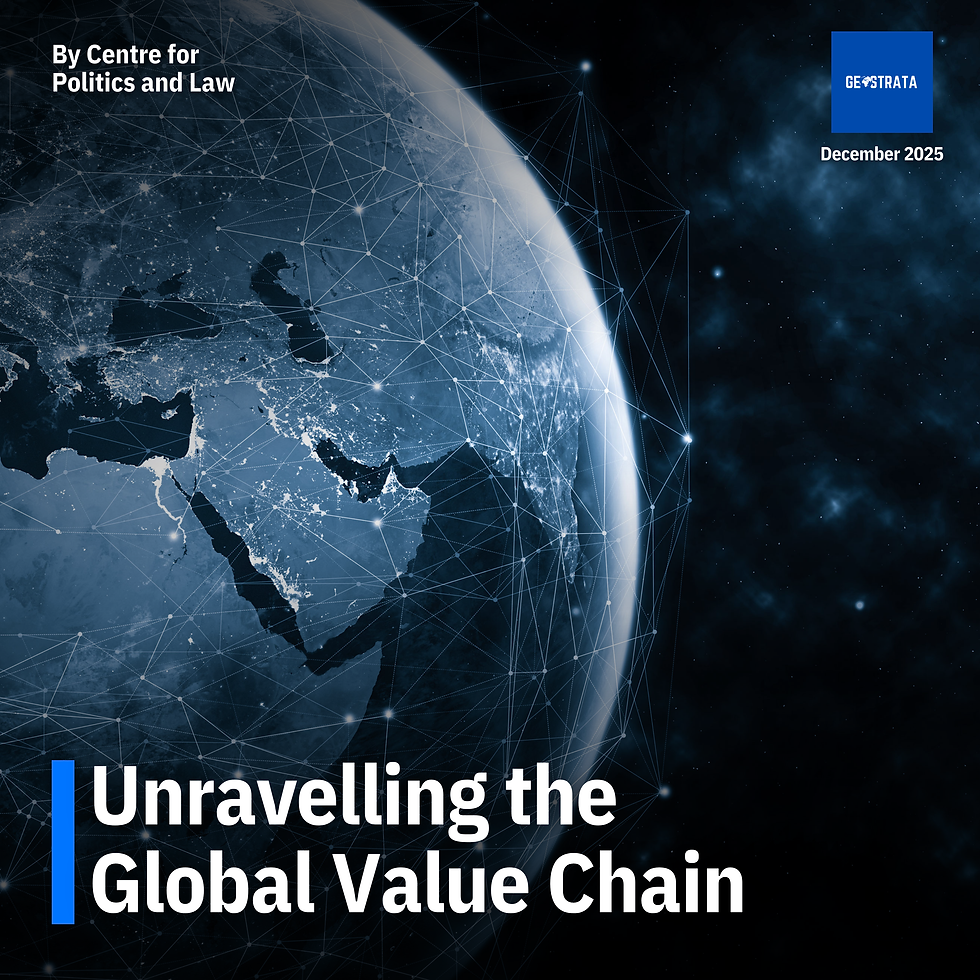Jihad Junction: Unveiling Pakistan's Export Model of Terrorism
- THE GEOSTRATA

- Jul 11
- 4 min read
Updated: Jul 13
Terrorism, undoubtedly, acts as a parasitic force, draining societies of peace and stability. From the 2001 Parliament attack to 26/11 Mumbai, Pathankot, Uri, and Pulwama, these horrifying events have claimed innocent lives, spread fear, disrupted development, and shattered communities, proving how deeply terrorism undermines national security, social harmony, and collective well-being.

Illustration by The Geostrata
The roots of Pakistan’s militant infrastructure lie in its frontier regions. When the Soviet Union invaded Afghanistan in 1979, Pakistan’s northwestern tribal belt (the former FATA) became the front line of jihad. The Pakistani state funnelled support (training, weapons, and ideology) through radical madrassas and Afghan mujahideen camps to drive out the Soviets. This period forged battle-hardened militant cadres and Islamist networks spanning FATA into neighbouring Afghanistan.
After the 1989 Soviet withdrawal, many of these fighters and teachings remained, forging a “ground zero of terrorism” in FATA.
Following the US-led invasion of Afghanistan in 2001, “the ground zero of terrorism moved from Afghanistan to FATA, which is now the single most important base of operations, a place where leaders, trainers, and planners are all located”. In short, Pakistan’s tribal areas, with porous Afghan borders, weak governance and a proliferation of hard-line seminaries, became sanctuaries for jihadist groups.
Gradually, by the mid-2010s, Pakistan’s militant infrastructure had evolved from frontier encampments into a nationwide threat. It drew from decades of jihadist teaching, tribal patronage and battle experience. In this way, Pakistan’s terror infrastructure grew organically from the Afghan war era into a self-sustaining system in FATA and beyond.
Major Jihadist Organisations in Pakistan:
Several prominent militant groups have flourished within this infrastructure. Each has its ideology, patrons and networks:
Lashkar-e-Taiba (LeT): A Salafi-jihadist organisation formed in the late 1980s, LeT’s primary aim is to “liberate” Jammu and Kashmir from Indian control. Over the decades, it became Pakistan’s premier proxy against India.
LeT gained global notoriety after orchestrating the November 2008 Mumbai attacks (166 killed, 300+ wounded), which targeted Westerners and symbols of Indian prominence. It runs military training camps near Muridke (Punjab) and often draws on unemployed youth and diaspora enthusiasts with anti-India narratives.
Jaish-e-Mohammed (JeM): Founded in 2000 by cleric Maulana Masood Azhar, JeM is also Pakistan-based and Deobandi in orientation. Its charter calls for merging Kashmir with Pakistan, and it has claimed responsibility for high-profile attacks against Indian targets (for example, the 2019 Pulwama suicide bombing that killed 46 soldiers, and was blamed for a 2001 assault on the Indian Parliament). Masood Azhar was freed by India in 1999 and immediately formed JeM, reportedly after meeting Taliban and al-Qaeda leaders in Afghanistan.
Haqqani Network: Though primarily an Afghan insurgent group, the Haqqani Network has deep roots in Pakistan. Founded by Jalaluddin Haqqani (a veteran anti-Soviet fighter) and now led by his son Sirajuddin, the Haqqanis are Taliban-aligned but semi-autonomous. They have “the backing of elements within the Pakistani security establishment” and are one of Afghanistan’s most experienced guerrilla organisations.
FUNDING TERROR INFRASTRUCTURE
Pakistan’s militancy ecosystem is financed by diverse, often illicit sources. A parallel terror economy has taken root, blending narco-trafficking, charitable donations and shadow banking.
Drug-smuggling and extortion are key pillars: numerous reports note that opium and heroin profits funnel to groups like the Taliban and TTP, often under the oversight of Pakistani intelligence.
Moreover, religious charities and foundations are another major source. Many groups maintain front organisations that solicit donations “for jihad” under a humanitarian guise. Additionally, modern financing has added new layers. Hawala – the informal money-transfer network – remains vital for moving funds overseas without banking scrutiny.
In sum, funding for Pakistan’s terror networks is multifaceted: state patronage underwrites a significant part, while a shadow economy of drugs, extortion and overseas donations fills in the rest. This financial ecosystem is entrenched and partially institutionalised – in effect a “state-sanctioned war chest” for jihad.
RADICALISATION AND INDOCTRINATION MECHANISMS
Terror groups in Pakistan cultivate recruits and propagate ideology through religious schools, media and curricula. Over 30,000 madrassas operate in Pakistan, and many are linked to extremist networks. These seminaries often teach ultraconservative Deobandi or Salafi curricula that emphasise jihadi concepts and depict India and the West as permanent enemies.
They inculcate young students with narratives of martyrdom and “defensive jihad” to liberate Kashmir and establish Sharia. Prominent hardline preachers in these madrassas issue fatwas urging jihad, thereby funnelling recruits directly into militant training camps.
Alongside institutional channels, online propaganda plays a growing role. In short, the radicalisation pipeline – from mosque to madrassa to social media – creates an atmosphere where militant ideology is normalised.
STATE PATRONAGE AND STRATEGIC AMBIGUITIES
Pakistan’s security establishment has historically viewed certain Islamist militias as strategic assets. Within parts of the military and ISI, jihadist proxies against India and Afghanistan were cultivated as instruments of policy. Hence, even as Pakistan fought wars against Islamist insurgents on its own soil, it often simultaneously nurtured other jihadist groups. For decades, much of the country’s terror network has “survived within its security establishment, which views these forces as strategic assets”.
This double game has meant persistent plausible deniability. Pakistani authorities often publicly condemn terrorism (especially after high-profile incidents or international pressure) and have occasionally arrested militants. However, evidence of high-level complicity is substantial. Many militant leaders (Masood Azhar, Hafiz Saeed, the Haqqanis) have long enjoyed safe havens or open travel inside Pakistan. In short, Pakistan’s terror infrastructure has flourished under an “all-weather” patronage that combines overt and covert support.
The April 2025 Pahalgam massacre in Indian-administered Kashmir, where militants (linked to LeT’s proxy The Resistance Front) killed 26 civilians, starkly demonstrates the cross-border reach of Pakistan’s terror networks. This brazen attack “marked a turning point” in South Asia’s security dynamic. India responded with Operation Sindoor, striking alleged terrorist camps across the Line of Control, while Pakistan retaliated rhetorically.
In conclusion, Pakistan’s terrorism infrastructure is vast and historically entrenched, blending ideology, finance and state networks into a resilient whole. The Pahalgam episode has underscored how deeply this infrastructure affects bilateral relations: terrorism is now inseparable from the India–Pakistan strategic rivalry. Dismantling it will require not just Indian resolve but a concerted global effort to isolate the patrons, disrupt the funding chains, and counter the radical narrative at its source.
BY TANU NAGAR
TEAM GEOSTRATA
.png)







Very critically analyzed!
Such a justified Title.